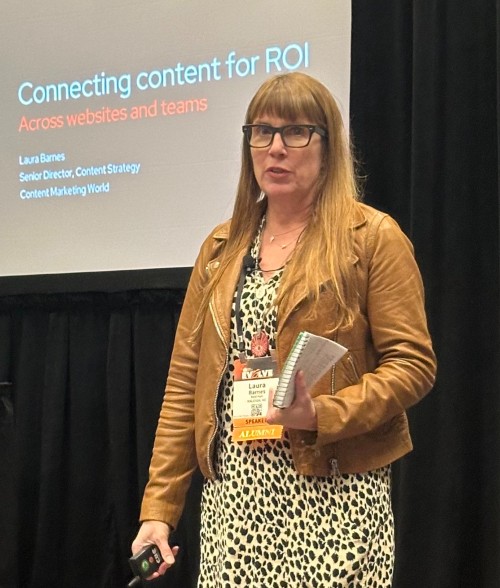For those of us in the world of B2B content marketing, we know that the customer journey isn’t always linear and the value of that content isn’t always easy to attribute. Laura Barnes, Senior Director of the Global Content Team at Red Hat, shed light on the importance of connecting content measurement across multiple customer touch-points during her recent presentation at Content Marketing World.
Here are a few of my main takeaways.
Content’s Non-linear Value:
Content doesn’t always follow a straightforward path. “Digital governance nirvana” might be a dream for some, but the goal for content marketing should be clear: connect content across the user’s journey. While reducing URLs may not be feasible for everyone, the ability to connect content cohesively is vital. By bridging the gaps, content teams can showcase their worth, irrespective of the volume of URLs they manage.

Laura Barnes, Senior Director, Global Content Team at Red Hat
Navigating the Web of URLs:
Red Hat itself operates 12 approved websites, emphasizing that every website is essentially something with a URL. However, URLs are often political. While content too can be, it’s typically to a lesser degree. Laura underscored the significance of accountability when it comes to content. In an environment where different sites might report to various teams or even have divergent budgets, establishing governance can be a challenge. Yet, defining clear objectives can encourage collaboration among disparate groups — which is essential.
The Open Source Way to Content Collaboration:
Drawing parallels with open-source principles, Laura shared some guidelines on how RedHat brings together teams with differing responsibilities:
Transparency: Everyone should have access to information, ensuring collaborative problem-solving. Barnes highlighted Red Hat’s “word nerds” group, which worked on creating a style guide.
Collaboration: Encourage spontaneous partnerships and collaborative problem-solving. By inviting teams to share common challenges, Red Hat created an alliance, further splitting into guilds to tackle specific areas.
Release Early and Often: Prioritize swift prototype releases, and share work in its early stages. Red Hat, for example, begins every meeting discussing four key performance indicators (KPIs).
Inclusive Meritocracy: All ideas have merit, ensuring a non-hierarchical approach. At Red Hat, teams collaborate on agreeing to metadata and taxonomy changes.
Frameworks for Valuable Content:
Content frameworks are essential because they provide a structured approach to content creation, ensuring consistency, clarity, and purpose. By defining guidelines and parameters, they streamline the content process, maintain brand voice, and ensure that content aligns with overarching business objectives. While the content universe is wide and diverse, Laura shared that certain frameworks can help streamline creation and dissemination including:
Metadata + Taxonomy: A consistent element, enabling flexibility elsewhere.
Messaging Guides: Collate vital information to ensure teams are well-informed and can act swiftly.
Templates: Establish guidelines on what remains consistent and what can be altered.
Translation Strategy: With many businesses being U.S.-centric, the content should cater to a global audience.
Global SEO: User-focused SEO frameworks can guide content creation across different sites.
Demonstrating Business Value:
To ensure continued support, funding, and growth, content teams must exhibit their tangible business value. Laura outlined several key metrics that Red Hat considers:
- Conversion (40% weight): Calls-to-action (CTAs) completed by users.
- SEO (15% weight): Organic traffic to pages.
- Visibility (20% weight): Both internal and external, encompassing unique visitors, cross-links, and organic impressions.
- Engagement (15% weight): Factors like form completions, next-page clicks, and page load time.
Today’s information experience for buyers of B2B products and services is proliferated with content. The challenge is not just creation but also effective connection and measurement. Drawing from Laura Barnes’ presentation, it’s clear that with the right strategies, teams can navigate the complexities of content measurement, ensuring that the content not only reaches its audience but also delivers tangible ROI.
To dig deeper into B2B content marketing and measurement, check out some of these posts:
- Growth Strategy: How Content Marketing Propels B2B Brand Growth Today
- How B2B Marketers Are Responding to Tough Market Conditions
- How to Prove the Value of Content Marketing to Your CMO in 3 Easy Steps
Learn more about the content marketing solutions we provide to some of the biggest B2B brands in the world.
The post RedHat on Connecting B2B Content for ROI – Across Sites and Teams appeared first on B2B Marketing Blog - TopRank®.
No comments:
Post a Comment